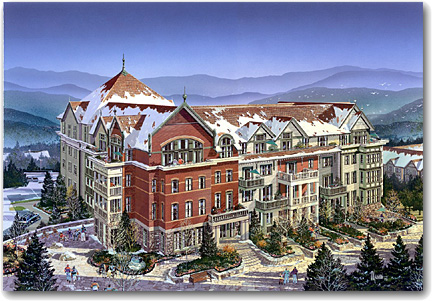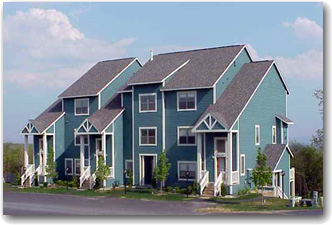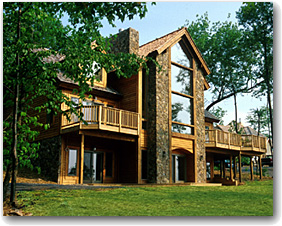
Every skier dreams of one day owning slopeside property. There’s nothing like having a forward base at a ski resort, not to mention a reserved parking spot above the base lodge. On a cold day, extra clothes are near at hand. If one gets hungry for something besides a generic lodge burger, one’s refrigerator and kitchen are right there. For pet owners, there are no guilty feelings about leaving one’s furry friend in the kennel over the weekend. Have I sold you on the concept yet?

|
|
The Seneca, Snowshoe’s newest real estate development. Photo provided by Snowshoe Mountain Resort.
|
Naysayers argue that no resort in the Mid-Atlantic is worth buying into. “You’ll get bored of the terrain quickly,” they warn. “To make Mid-Atlantic skiing interesting, you need to visit a different resort every weekend.” Others warn of the expense of ski property and its poor investment potential.
When I first thought of buying a slopeside unit at Timberline in summer of 2001, it was painfully obvious that ski properties at this resort were questionable investments. For the past ten years, there had been little capital appreciation for units at my development. Moreover, local realtors warned me that I would never cover my mortgage and other expenses from rental income. The situation scared me but I took the plunge anyway because for me, visions of snowy slopes always trump rational financial decision-making.
Two years later, I am pleased to report that the market value of my property has increased by over 30%. More importantly, I have experienced snow beyond my wildest dreams. Having spent many a weekend in the wilds of West Virginia, I can now boast that I no longer miss New England in the winter. I still ski at other places to mix things up, but believe it or not I have yet to get bored of the terrain at Timberline -; even after 27 ski days on the mountain.
Admittedly, there have been downsides to condo ownership. When I bought the unit, I had to purchase some furniture, and had some work done on the interior. Later on, I needed to replace a dishwasher and garbage disposal. If that weren’t enough, we have had three special assessments since I moved in: one for roof replacement, another to cover skyrocketing insurance rates, and a third for painting and deck repair. If the costs of those assessments along with my own personal upgrades are deducted from my profits, my real gains over the past two years stand at roughly 15 percent.
Intrigued with the upward trend in Mid-Alantic ski real estate, I asked my brother Damon Sherwood, a realtor with Coldwell Banker in the Boston area, why I have made money in Timberline real estate despite the fact that the resort has changed very little in the two years I have owned a property there.
“People are continuing to pull money out of the stock market and sinking it into second properties,” he explained. “With a second property, you will at least enjoy your money even if the second home market turns south, which incidentally, I don’t think it will. Leisure and quality time have emerged as some of the most valuable commodities in this age of uncertainty.”
I asked Damon, also a skier, what mountains in New England he advises his clients to invest in.
“I like Stowe, Okemo, and Stratton Mountain,” he explained. “In ski real estate, the financial fate of your property is directly linked to the financial fate of the resort it sits on. Therefore, I look for resorts that have either invested heavily in infrastructure improvements over the years or those that plan on undertaking massive investments.”
Applying these same rules to Mid-Atlantic real estate, I decided to take a closer look at three of the most promising real estate investment opportunities in the region: Snowshoe, Seven Springs, and Wisp. I could have added several more areas to this list, but in the interests of time and space, I chose to limit the article to promising real estate opportunities beyond a two-hour drive from DC.
Snowshoe is almost in a class by itself. It offers the most extensive terrain and the best lift system in region, not to mention the only purpose-built ski village. It also has the most ambitious terrain expansion plans. Snowshoe is currently widening slopes on the Basin side. Plans are also in the works to add additional terrain in the Western Territory, although a timetable is not yet in place and is dependent on environmental studies. As a result of its current strengths and future prospects, Snowshoe has one of the hottest real estate markets in the region right now.
On March 24, 2003, Snowshoe sold $12 million dollars worth of real estate in its newest property, the Seneca, in just 7 hours. The average price for a condominium in this luxury development is $330,000.
“There continues to be a great interest in real estate offerings we are developing here at Snowshoe,” says Becki Furbee, Director of Sales and Marketing for Intrawest Development at Snowshoe Mountain.
“Intrawest has created a unique attraction with the mountain top village that provides a place to create family memories and renew relationships. Something that is very important in today’s world.”
The Seneca will be the fourth offering of mountain homes constructed in the Village at Snowshoe, following Rimfire Lodge, Highland House and Allegheny Springs.
The success of Snowshoe is not limited to Intrawest developed properties. All property on the mountain has benefited from the tremendous investments Intrawest has made in the mountain since it purchased Snowshoe in 1995. Here are a few examples of “then and now” property values within the Snowshoe Mountain market furnished by Doug Keith of Keith Realty at Snowshoe:
“These examples are pretty indicative of the mountain as a whole, neither the highest nor the lowest,” claims Keith, a realtor who has worked at Snowshoe for 30 years. The biggest factor driving real estate prices up “have been terrain and lift expansion.”
Concerned about over development, I asked Keith about how new Intrawest properties are affecting the overall market. He explained that many of the new properties were built to replace aging hotels formally owned by the resort. More importantly, he explained, “newer properties like the Seneca are actually pulling prices of older properties up.” These properties, in other words, keep pushing price ceilings higher and higher.
They are also convincing homeowners to upgrade older units to cash in on higher rental rates established by the new luxury developments. Higher rents, in turn, translate directly to higher resale values. For example, the Wabasso two bedroom condos recently levied an assessment for siding and deck replacement. 18 months later, those units are selling at prices $30,000 to $40,000 higher than before the repairs were made.
Intrawest’s vision for the mountain and its emphasis on quality are transforming the real estate market there. This vision extends beyond obvious infrastructure improvements to aspects of the resort skiers rarely consider. “Events such as symphony weekend, the Wine and Jazz festival, and the Chili Cook-off have really spurred summer rentals, which of course has pushed property values upwards,” claims Keith. Mountain biking and golf also help the summer business, and Snowshoe has worked hard to develop world-class terrain for both sports.
Intrawest, however, is not simply a real estate developer. It is also the biggest stakeholder in mountain, and a defender of all its virtues. Lifts must run perfectly. Snow must always be as good as nature will allow. Everything about the mountain must be pleasing to guests so they will return and bring more guests. Intrawest works fanatically hard to regulate all aspects of the mountain to achieve this goal. According to Hal Clifford, the former real estate editor for Ski Magazine, Intrawest carefully decides “who gets to do business there, what business they do, under what terms it will be done, what public face they will present, and even the hours they will be open.” If enough skiers complain about the service or food at a restaurant, Intrawest will shut it down and bring in a new food purveyor. It’s that simple. Quality really is “job one” for this owner of the “great playgrounds of the western world.” Not surprisingly, real estate at Snowshoe is booming.
Snowshoe may be leading the Mid-Atlantic ski real estate bonanza, but it is certainly not the only resort to experience sharp upward movement in real estate prices.
The Ski Magazine reader’s survey recently voted Seven Springs as the number one resort in the Mid-Atlantic. Positive national press and good reviews from longtime locals like DCSki’s Jim Kenney (see this review by Jim) have made this resort quite popular for those in the market for ski homes.

|
|
|
The average values of condominiums at Seven Springs have increased by over 40 percent since 1995.
“The big problem for us right now is low inventory,” claims Forelines. Of the 950 condominiums at the resort, only 16 are currently on the resale market. Eventually the housing shortage at Seven Springs will be solved by new developments promised in the resort’s $230 million dollar 5-year expansion plan. Already, the resort has added a new, high speed 6-pack -; the only one in the region. Eventually, the resort plans to double its on-site lodging.
According to Seven Springs President Scott Bender, “We are placing a lot of emphasis on real estate due to pent up demand. We’re pursuing a possible ski-in, ski-out development at Lake Tahoe right now. The development will consist of 150 two, three, and four bedroom town homes.”
Bender hopes to be able to run an IPO for these homes sometime this Fall. The units will run for between $240,00-$350,000. When asked about terrain expansion to accommodate additional skiers, Bender explained that Seven Springs owns 125 acres of skiable terrain near the North Face. “There’s about 700 feet of vertical there. The Territory is called the Great Western.”
Like Snowshoe, expectations for infrastructure improvement at Seven Springs are high and these expectations are fueling a boom that may soon rival Snowshoe’s.
The Wisp is the big up and coming resort in the Mid-Atlantic. Two years ago, new management took over the mountain, changing future expectations overnight and fueling a veritable explosion in real estate prices.
A half-acre unimproved plot of land at the Highline development, purchased two years ago for $62,000, sold in March of this year for $259,000. No improvements were made to that lot. In two year’s time, this home lot more than quadrupled in value. Others in the development have tripled in value in just a single calendar year. A lot that went for $50,000 last year, for example, recently sold for $159,000.
Like Snowshoe and Seven Springs, Wisp is also developing new condominium properties. A resort sub-developer recently optioned 9 three- and four-bedroom condominiums at the proposed Overlook Villas development for between $375,000 and $475,000 per unit. 21 more units will eventually be built at this slopeside establishment.

|
|
|
“Since 9/11, people have been looking for a four season getaway within a three hour drive, and Wisp fits the bill,” explained Myers.
Through tangible improvements, the new ownership at Wisp has also demonstrated its commitment to the ski resort. Here are a few examples of major improvements accomplished by Wisp in the past two years:
This year Wisp plans even more improvements, including lift enhancements in the beginner area. Next year, a lodge and new beginner area are planned for the summit. Eventually, the summit development will include a mountaintop village and twice as much ski terrain as what is currently offered. For summer fun, the new mountaintop area will also eventually include North America’s first re-circulating white water course -; a $9.5 million dollar endeavor.
Lest anyone accuse me of pumping an already hot ski real estate market in the Mid-Atlantic, it is important to remind readers that like any investment, real estate is a risk. In the early 1990s, the region suffered a real estate recession. As Karen Myers pointed out to me, those who purchased 3 bedroom units at The Villages of Wisp in 1988 for $140,000 could only get $80,000 for them in the early 1990s.
However, owners who patiently held on to their investments can now fetch sums greater than $259,000 or more for those very same properties. The lesson is clear: real estate goes up and down just like any other market. Future expectations lead to higher prices, but as we all know, future expectations don’t always pan out.
Robust corporations with deep pockets currently manage Snowshoe, Wisp, and Seven Springs. Hopefully, the economy will support their ambitious expansion plans. Given the demographics of this area, I believe that these resorts and many others in the region are at least as good of a bet as most growth stocks. In any event, even if your condo investment declines, you can at least enjoy it for skiing. You can’t say that about worthless stocks.
Photos provided by Snowshoe Mountain Resort, Seven Springs, and Wisp.
John Sherwood is a columnist for DCSki. When he's not hiking, biking, or skiing, he works as an author of books on military history.